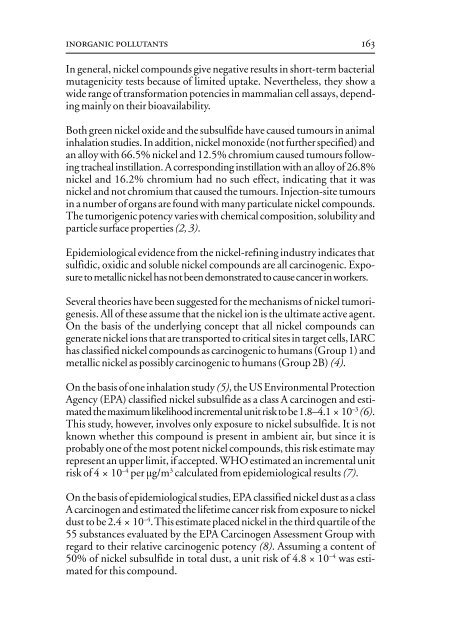Air Quality Guidelines - World Health Organization Regional Office ...
Air Quality Guidelines - World Health Organization Regional Office ...
Air Quality Guidelines - World Health Organization Regional Office ...
Create successful ePaper yourself
Turn your PDF publications into a flip-book with our unique Google optimized e-Paper software.
inorganic pollutants<br />
163<br />
In general, nickel compounds give negative results in short-term bacterial<br />
mutagenicity tests because of limited uptake. Nevertheless, they show a<br />
wide range of transformation potencies in mammalian cell assays, depending<br />
mainly on their bioavailability.<br />
Both green nickel oxide and the subsulfide have caused tumours in animal<br />
inhalation studies. In addition, nickel monoxide (not further specified) and<br />
an alloy with 66.5% nickel and 12.5% chromium caused tumours following<br />
tracheal instillation. A corresponding instillation with an alloy of 26.8%<br />
nickel and 16.2% chromium had no such effect, indicating that it was<br />
nickel and not chromium that caused the tumours. Injection-site tumours<br />
in a number of organs are found with many particulate nickel compounds.<br />
The tumorigenic potency varies with chemical composition, solubility and<br />
particle surface properties (2, 3).<br />
Epidemiological evidence from the nickel-refining industry indicates that<br />
sulfidic, oxidic and soluble nickel compounds are all carcinogenic. Exposure<br />
to metallic nickel has not been demonstrated to cause cancer in workers.<br />
Several theories have been suggested for the mechanisms of nickel tumorigenesis.<br />
All of these assume that the nickel ion is the ultimate active agent.<br />
On the basis of the underlying concept that all nickel compounds can<br />
generate nickel ions that are transported to critical sites in target cells, IARC<br />
has classified nickel compounds as carcinogenic to humans (Group 1) and<br />
metallic nickel as possibly carcinogenic to humans (Group 2B) (4).<br />
On the basis of one inhalation study (5), the US Environmental Protection<br />
Agency (EPA) classified nickel subsulfide as a class A carcinogen and estimated<br />
the maximum likelihood incremental unit risk to be 1.8–4.1 × 10 –3 (6).<br />
This study, however, involves only exposure to nickel subsulfide. It is not<br />
known whether this compound is present in ambient air, but since it is<br />
probably one of the most potent nickel compounds, this risk estimate may<br />
represent an upper limit, if accepted. WHO estimated an incremental unit<br />
risk of 4 × 10 –4 per µg/m 3 calculated from epidemiological results (7).<br />
On the basis of epidemiological studies, EPA classified nickel dust as a class<br />
A carcinogen and estimated the lifetime cancer risk from exposure to nickel<br />
dust to be 2.4 × 10 –4 . This estimate placed nickel in the third quartile of the<br />
55 substances evaluated by the EPA Carcinogen Assessment Group with<br />
regard to their relative carcinogenic potency (8). Assuming a content of<br />
50% of nickel subsulfide in total dust, a unit risk of 4.8 × 10 –4 was estimated<br />
for this compound.

















